Did you know that nearly 30% of trolling motor failures are due to neglected propeller maintenance? As boating enthusiasts, we recognize the importance of keeping our equipment in top shape, especially when it comes to the propeller's efficiency and safety. We often forget routine inspections and maintenance, leading to costly replacements and compromised performance. But how do we recognize when it's time to replace a propeller, and what steps can we take to extend its lifespan? Let's explore some essential tips for maintaining our trolling motor props at their best.
Importance of Regular Inspections
Conducting regular inspections of our boat's propeller is crucial for guaranteeing safety and efficiency during use. In the world of boating, paying attention to the propeller's condition is like reading chapters from a history book filled with tales of smooth journeys and curious encounters with the deep blue.
We must arm ourselves with the right inspection tools to keep our adventures on the water trouble-free. Regularly checking the propeller for weeds and fishing line is essential as leaving such obstructions can damage the motor's internal mechanisms.
Imagine setting sail without a care, knowing our propeller blades are free from nicks, dings, or cracks. It sounds liberating, right? By inspecting the propeller every 20 hours of use or even daily, we catch any signs of damage before they turn into bigger problems.
A propeller's balance and alignment, too, tell a story—one that we can read by comparing angles and checking the blade's curves with a straight edge or ruler.
For those minor dings, a mill file comes in handy, smoothing out the bumps and keeping things running efficiently. Regular cleaning and greasing of the prop shaft guarantee that nothing hinders our freedom on the water.
Let's keep the spirit of our voyages alive by committing to these inspections.
Identifying Common Propeller Issues
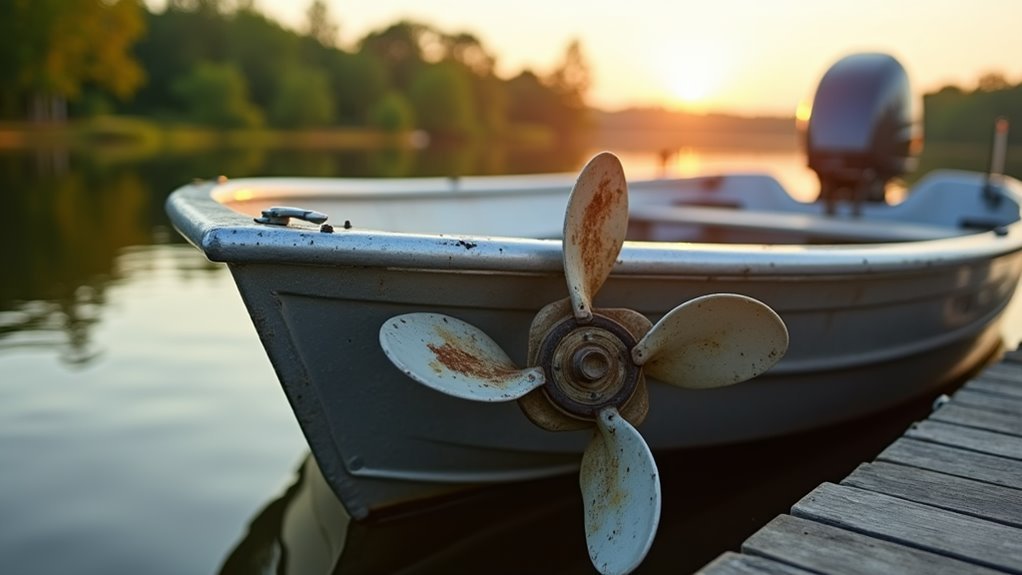
When we're out on the water, addressing common propeller issues promptly is key to maintaining peak performance and safety. Let's start by recognizing how different propeller materials handle various water conditions. Whether we're dealing with choppy waves or smooth sailing, inspecting our propeller often is essential. Look for bent blades that might cause vibrations or chipped and cracked surfaces that could worsen with use. Rust or corrosion, especially around the nut and pin, can signal it's time for some attention.
Vibration and noise aren't just annoying; they suggest wear or even an unbalanced propeller. If we notice reduced performance or increased power consumption, our trusty propeller might need help. Also, corrosion in wiring can lead to inconsistent motor operation, emphasizing the need to regularly check for any electrical issues. Let's also keep an eye out for visible wear marks and loose nuts, which could lead to operational hiccups.
Common causes of these issues might be impact damage from hitting submerged objects or the wear and tear from saltwater corrosion. Poor installation and overuse contribute too. By performing visual inspections and conducting performance tests, we can identify these issues early.
Should we find ourselves uncertain, calling in a professional guarantees we're steering freely without concern.
Cleaning and Lubrication Techniques
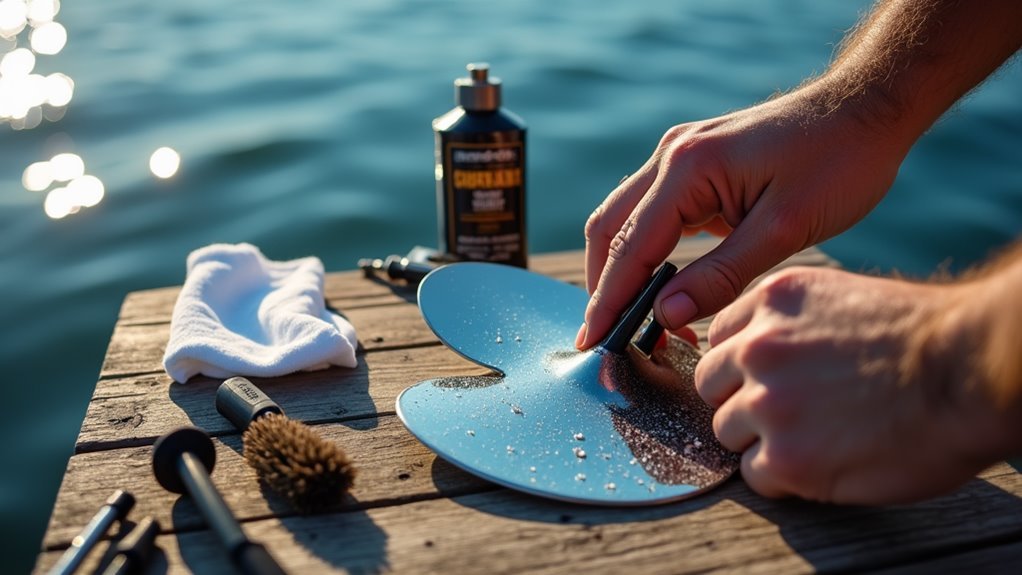
As we guarantee our propeller's integrity, let's focus on keeping it clean and well-lubricated. If we want our trolling motor propellers to remain strong and efficient, understanding proper cleaning and lubrication techniques is key.
Starting with a soft cloth, mild soap, a non-abrasive brush, and a basin is essential for effective cleaning. Gently remove any debris with a plastic tool to avoid scratching the surface, confirming material compatibility in our approaches.
Next, soaking the propeller in a diluted acidic or vinegar solution helps dissolve those stubborn mineral deposits. Remember, chemical safety is important, so wear gloves and follow guidelines to protect both ourselves and our components. Additionally, it's recommended to perform monthly thorough cleanings to maintain optimal performance, especially for those boating in saltwater environments.
After a gentle scrub, a thorough rinse with a hose removes all residues. This regular cleaning reduces corrosion and keeps our propeller in prime condition.
Let's not forget about lubrication. Using manufacturer-approved greases prevents issues like leaks and guarantees performance. By applying a touch of lubricant to key parts, like the propeller nut, we prevent rust and simplify future maintenance.
Regular inspections, storage in a dry place, and consistent servicing amplify our propeller's longevity. Embrace these practices for lasting efficiency and independence on the water.
Detecting and Fixing Vibration Problems
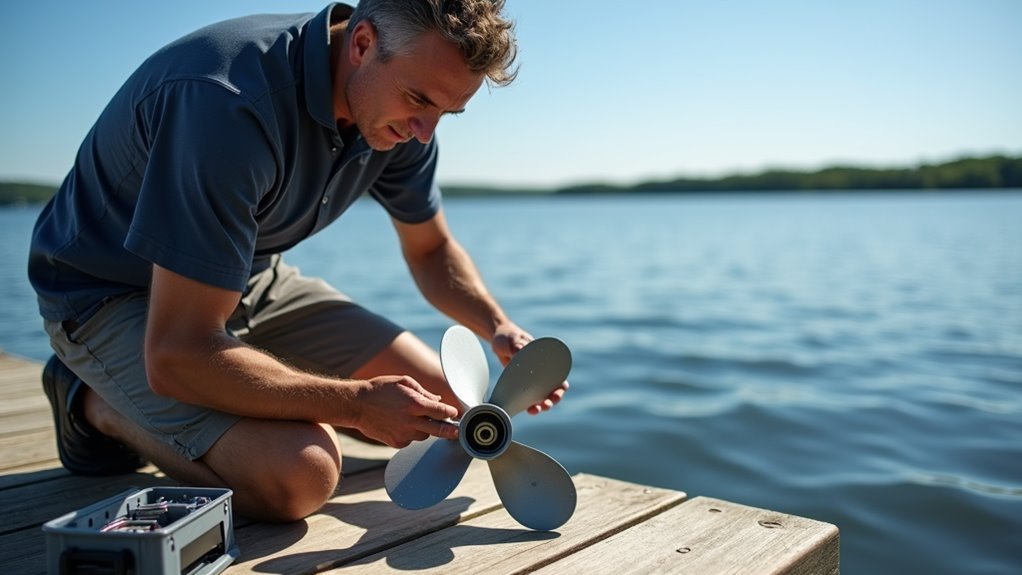
Vibration issues can sneak up on us, disrupting the performance of our trolling motor. We understand that we all crave smooth and carefree rides, so let's explore potential vibration sources and how to address them.
Bent or damaged propeller blades often cause vibration, shaking our freedom-sailing dreams. Correct propeller alignment is vital, with a keen eye needed to spot asymmetrical gaps or crookedness in the propeller collar. To further enhance performance, consider using a different type of propeller, like the Kipawa prop, to eliminate persistent vibration problems.
Dynamic balancing can help, ensuring our propellers spinning smoothly at all speeds. Detecting misalignment requires careful inspection. We should look for visible unevenness and consider re-indexing the propeller if it's off-balance.
Dynamic balancing demands we pay attention at the RPM where vibration is most pronounced. Using portable balancing tools allows us to tweak and adjust our setup efficiently. This doesn't just smooth out the ride; it's our ticket to an easier maneuver when traversing open waters.
Remember that regular balancing not only fends off vibration but helps extend the motor's lifespan. Armed with this knowledge, we'll keep our rides harmonious and free. We can sail with ease, knowing we've addressed and fixed these pesky vibration issues.
Assessing Damage and Wear
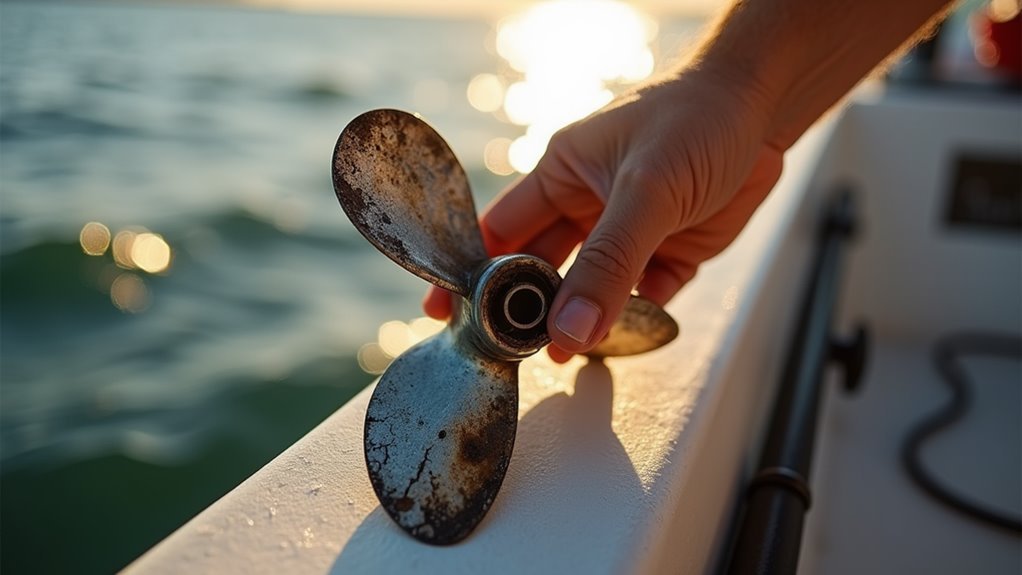
Understanding the wear and tear on our trolling motor's propeller is vital for maintaining a smooth ride. Let's delve into how we assess the damage and wear to guarantee the structural integrity of our propellers. First, a visual inspection helps us spot nicks, dings, and cracks. We might find rolled tips or bent blades, so it's smart to use a ruler to check angles. Let's also feel for abnormalities by lightly running a finger around those blades. Regularly checking propellers for pitting or discoloration is crucial in preventing long-term damage.
| Inspection Technique | Details | Tools Needed |
|---|---|---|
| Visual Inspection | Check for nicks, dents, and bent blades | Ruler, fingers |
| Component Inspection | Look at the hub and rubber for signs of damage | Visual cues |
| Advanced Techniques | Use MRI Prop Scan and NDT tests | Technical equipment |
Next, component inspections are vital. We inspect the center hub for any signs of failure and check the rubber for dry rot. These steps are essential to keep everything balanced and damage-free. It's also beneficial to utilize advanced methods like MRI Prop Scan and dye penetrant testing. These techniques help examine the material analysis and reveal hidden damages that aren't easily visible.
Signs You Need a New Propeller

Here are some signs indicating a new propeller might be in order:
- Sluggish Performance: If accelerating feels like a snail's race, it might be time for a change.
- Increased Fuel Use: Notice we're burning through more fuel? That's a red flag.
- Unusual Vibration: Feeling strange vibrations? It's not just the water—it's our propeller talking. Regular cleaning of the propeller helps prevent weed buildup, which can also lead to increased vibrations.
- Visible Damage: Cracks or dents are clear indicators that it's time to seek a trusty replacement.
- Excessive Noise: If the boat sounds like a chainsaw, it's trying to tell us something's awry.
Choosing the Right Replacement Propeller
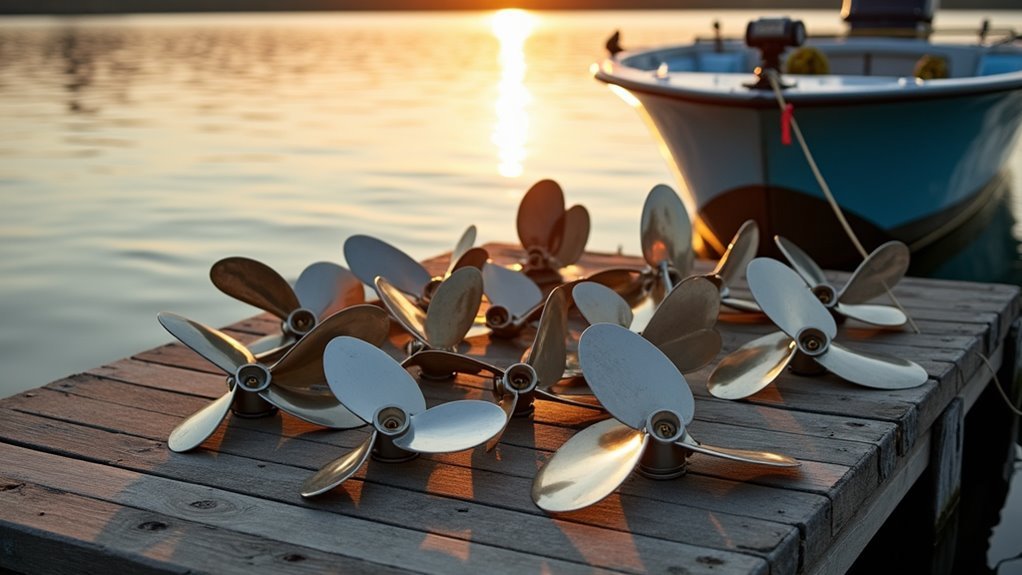
How do we choose the perfect replacement propeller for our trolling motor? It's all about balancing performance with durability while guaranteeing compatibility. First, think about where we often use our trolling motor. For open waters, a two-blade propeller may be best as it prioritizes speed and efficiency, easily maneuvering through clear waters. However, it struggles with weeds—something to keep in mind. In contrast, a three-blade propeller works wonders in weed-infested areas, minimizing entanglement in aquatic plants. Its blade design is crafted to tackle submerged grass beds efficiently. Speaking of efficiency, when choosing propellers for larger boats, consider that two-blade propellers offer more power and thrust advantage due to their broader diameter, making them suitable for engines requiring high output. Let's not forget about propeller materials. Durable materials like composite and stainless steel can provide longevity and withstand impacts better than softer materials. But remember, the propeller we choose must match our motor's specifications. This includes the propeller diameter, motor shaft diameter, and even the serial number of our trolling motor. Understanding these elements guarantees we select a compatible propeller that performs at its best. Always double-check these specifications before purchase.
Tips for Extending Propeller Lifespan
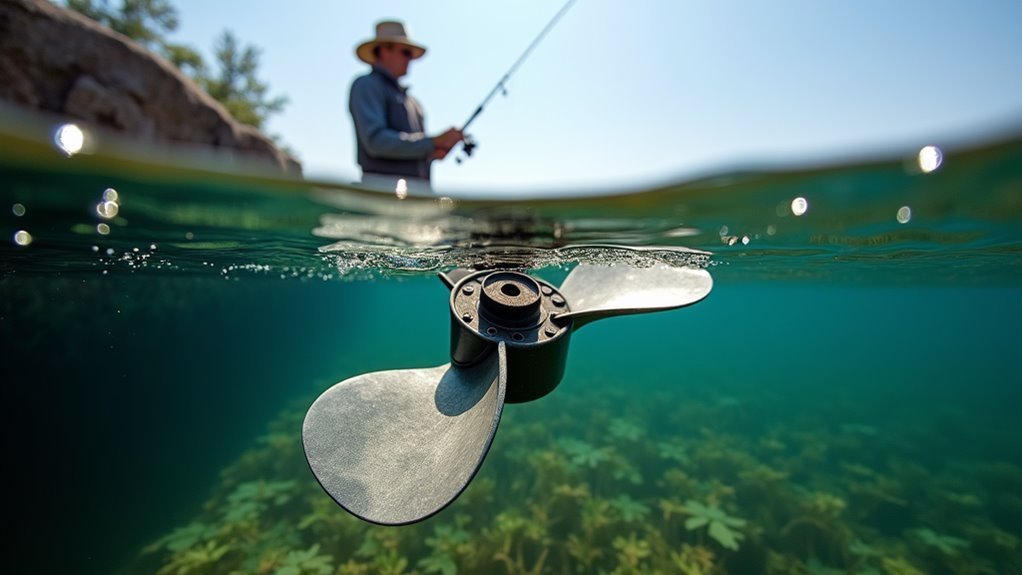
Here are some practical tips to extend our propeller's lifespan:
- Regular Inspections: Examine the propeller for nicks, dents, or severe damage, which can affect performance.
- Thorough Cleaning: Remove debris and fishing lines from behind the trolling motor prop, and wash with fresh water to prevent corrosion.
- Lubrication: Use water-based silicone spray on moving parts and lubricate the trolling motor shaft to reduce friction and wear.
- Tightening Checks: Verify that mounting bolts are tight and the trolling motor prop drive pin isn't damaged or corroded. Regular adjustment of thrust settings can also help optimize battery life and prevent unnecessary wear on the motor.
- Smart Storage: Store the trolling motor in a dry, protected area to prevent corrosion.
Frequently Asked Questions
How Do Environmental Factors Affect Trolling Motor Prop Performance?
Environmental factors like water resistance and sediment buildup affect our trolling motor prop's performance. Cold water and proper maintenance help enhance efficiency, while sediment can drag us down, reminding us to keep our equipment in top shape for freedom on water.
Can Propeller Imbalance Lead to Battery Drainage?
Yes, propeller imbalance can drain batteries. When we experience vibration issues, it increases motor strain, working harder and drawing more power. Let's guarantee freedom on the water by balancing our props for peak performance and battery life.
What Tools Are Essential for DIY Propeller Maintenance?
In our nautical journey, maintaining our vessel's propeller is key. For effective DIY maintenance, use cleaning tools for debris removal and storage care essentials. Embrace freedom on the water by keeping your propeller in top form.
Should I Use Aftermarket or OEM Propellers for Replacement?
We'll weigh cost comparison and durability testing for propeller replacement. OEM offers reliability and performance, but comes at a price. Aftermarket provides budget options and variety, though risks durability issues. Let's choose what fits our freedom-focused needs.
How Does Propeller Pitch Influence Trolling Motor Efficiency?
When it comes to trolling motor efficiency, pitch optimization is key. It's like finding the perfect chord that harmonizes acceleration with speed. By optimizing propeller pitch, we can enhance performance and enjoy smoother, more efficient voyages.
Conclusion
As we navigate the waters of propeller care, let's remember it's like tending to a garden—regularly checking, cleaning, and nourishing so it flourishes. By doing so, we keep our trolling motor running smoothly and avoid pesky problems down the line. Listen to what your propeller tells you; if it's whispering about vibrations or wear, it might be time to replace it. Choose wisely, and you'll enjoy many more adventures on the water together.